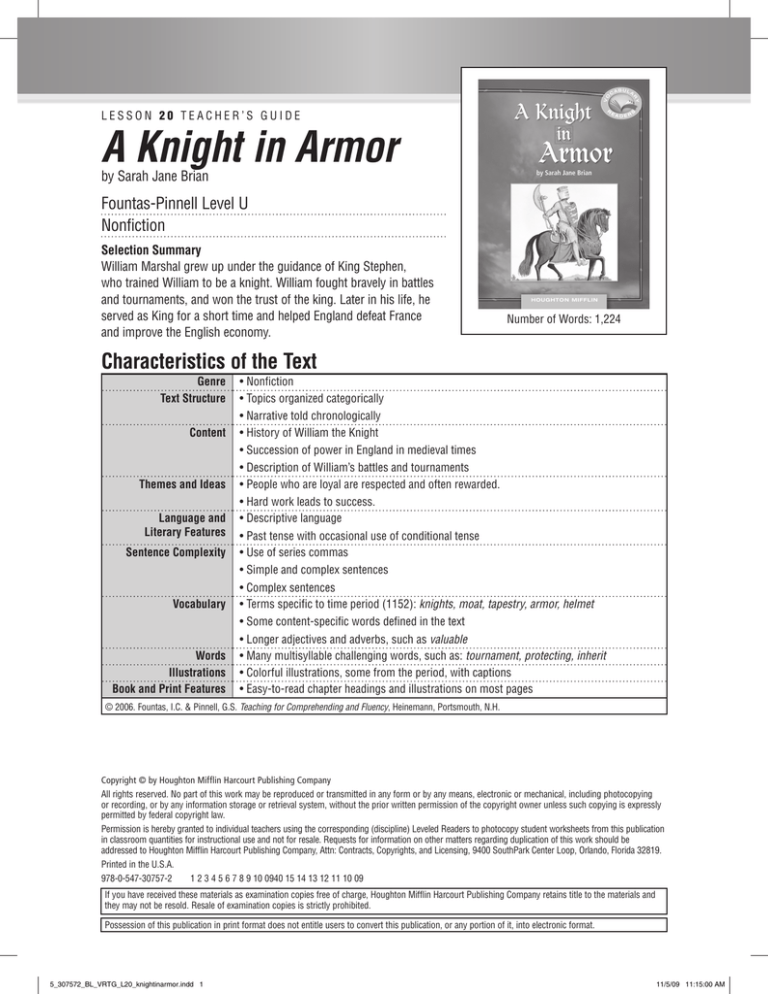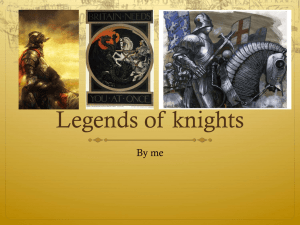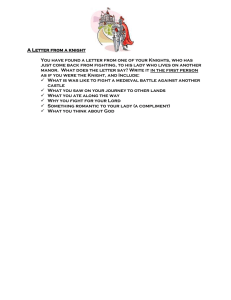
LESSON 20 TEACHER’S GUIDE
A Knight in Armor
by Sarah Jane Brian
Fountas-Pinnell Level U
Nonfiction
Selection Summary
William Marshal grew up under the guidance of King Stephen,
who trained William to be a knight. William fought bravely in battles
and tournaments, and won the trust of the king. Later in his life, he
served as King for a short time and helped England defeat France
and improve the English economy.
Number of Words: 1,224
Characteristics of the Text
Genre
Text Structure
Content
Themes and Ideas
Language and
Literary Features
Sentence Complexity
Vocabulary
Words
Illustrations
Book and Print Features
• Nonfiction
• Topics organized categorically
• Narrative told chronologically
• History of William the Knight
• Succession of power in England in medieval times
• Description of William’s battles and tournaments
• People who are loyal are respected and often rewarded.
• Hard work leads to success.
• Descriptive language
• Past tense with occasional use of conditional tense
• Use of series commas
• Simple and complex sentences
• Complex sentences
• Terms specific to time period (1152): knights, moat, tapestry, armor, helmet
• Some content-specific words defined in the text
• Longer adjectives and adverbs, such as valuable
• Many multisyllable challenging words, such as: tournament, protecting, inherit
• Colorful illustrations, some from the period, with captions
• Easy-to-read chapter headings and illustrations on most pages
© 2006. Fountas, I.C. & Pinnell, G.S. Teaching for Comprehending and Fluency, Heinemann, Portsmouth, N.H.
Copyright © by Houghton Mifflin Harcourt Publishing Company
All rights reserved. No part of this work may be reproduced or transmitted in any form or by any means, electronic or mechanical, including photocopying
or recording, or by any information storage or retrieval system, without the prior written permission of the copyright owner unless such copying is expressly
permitted by federal copyright law.
Permission is hereby granted to individual teachers using the corresponding (discipline) Leveled Readers to photocopy student worksheets from this publication
in classroom quantities for instructional use and not for resale. Requests for information on other matters regarding duplication of this work should be
addressed to Houghton Mifflin Harcourt Publishing Company, Attn: Contracts, Copyrights, and Licensing, 9400 SouthPark Center Loop, Orlando, Florida 32819.
Printed in the U.S.A.
978-0-547-30757-2
1 2 3 4 5 6 7 8 9 10 0940 15 14 13 12 11 10 09
If you have received these materials as examination copies free of charge, Houghton Mifflin Harcourt Publishing Company retains title to the materials and
they may not be resold. Resale of examination copies is strictly prohibited.
Possession of this publication in print format does not entitle users to convert this publication, or any portion of it, into electronic format.
5_307572_BL_VRTG_L20_knightinarmor.indd 1
11/5/09 11:15:00 AM
A Knight in Armor
by Sarah Jane Brian
Build Background
Help students use their knowledge of knights to visualize the selection. Build interest by
asking questions such as the following: What are knights? What is armor used for? Read
the title and author and talk about the cover illustration. Tell students that this selection is
nonfiction, so the facts and descriptions are true.
Introduce the Text
Guide students through the text, noting important ideas and nonfiction features. Help with
unfamiliar language so they can read the text successfully. Give special attention to target
vocabulary. Here are some suggestions:
Page 2: Point out that captions can give clues about information in the text.
Suggested language: How does the caption help you understand the illustration?
What can you tell about battles in these times from the picture?
Pages 4–6: Explain that over the years, armor changed, just like military uniforms
have changed in modern times. Have students look at the illustrations and read
the captions on pages 4 and 6. Ask: What kind of weapon of that time might pierce
armor? Do you think their armor protected the knights? Do you think that their
armor could be pierced?
Pages 6–7: Discuss the illustration and read the caption. When the knights fought
in tournaments, they played by the rules. The knights thrust their swords at one
another. Have students demonstrate a thrusting motion.
Pages 11–12: Explain that this drawing shows another tournament. Ask: Do these
tournaments look like they might have been dangerous? Why? William was such
a skillful fighter that his exploits became well-known. Besides tournaments, what
other exploits might a noble knight have had?
Now turn back to the beginning of the text to read about how William became a
famous knight.
Target Vocabulary
antique – made many years ago,
p. 7
exploits – brave or daring
actions, p. 11
faithful – loyal, p. 10
ignorance – a lack of knowledge
or awareness of important
things, p. 7
noble – honest, brave, and
unselfish, p. 12
pierced – having a hole poked in
something, p. 6
Grade 5
2
plagued – constantly bothered by
something, p. 13
quests – journeys undertaken in
order to find something, p. 10
thrust – to push in forcefully, p. 6
transformed – totally changed,
p. 14
Lesson 20: A Knight in Armor
© Houghton Mifflin Harcourt Publishing Company
5_307572_BL_VRTG_L20_knightinarmor.indd 2
7/29/09 12:30:44 PM
Read
Have students read silently while you listen to individual students read aloud. Support their
understanding of the text as needed.
Remind students to use the Question Strategy
questions before they read, as they read, and after they read.
as they read and to ask
Discuss and Revisit the Text
Personal Response
Invite students to share their personal responses to the selection.
Suggested language: How would you describe William the knight? Do you think he was
an unusual knight? Why or why not?
Ways of Thinking
As you discuss the text, help students understand these points:
Thinking Within the Text
Thinking Beyond the Text
Thinking About the Text
• William was a child hostage and
grew up to become a knight.
• When people are loyal to others,
they are often given respect in
return.
• The headings serve as an
overview of the text that follows.
• As a knight, William was brave,
noble, and trustworthy.
• William was rewarded for being
a faithful and trustworthy knight.
• Hard work and skill can lead to
success.
• Noble deeds are often rewarded.
• The photographs help readers
visualize the content, and the
captions expand on information
in the text.
• Although the sections are topical,
they offer a chronology of
William’s life.
© 2006. Fountas, I.C. & Pinnell, G.S. Teaching for Comprehending and Fluency, Heinemann, Portsmouth, N.H.
Choices for Further Support
• Fluency Invite students to choral read a passage from the text. Remind them to pay
attention to punctuation and to stress certain words to sound as if the narrator is
actually speaking.
• Comprehension Based on your observations of the students’ reading and discussion,
revisit parts of the text to clarify or extend comprehension. Remind students to go
back to the text to support their ideas.
• Phonics/Word Work Provide practice as needed with compound words, using
examples from the text. Remind students that compound words are made up of two
smaller words. Knowing the meanings of the two smaller words helps determine
the meaning of the compound word. For example, in the word horseback on page
2, knowing the meaning of the two smaller words horse and back helps readers
understand that horseback means “to ride on a horse’s back.” Have students find
other examples of compound words and ask them to explain the meanings of the two
smaller words each one is made up of.
Grade 5
3
Lesson 20: A Knight in Armor
© Houghton Mifflin Harcourt Publishing Company
5_307572_BL_VRTG_L20_knightinarmor.indd 3
12/10/09 3:54:09 PM
Writing about Reading
Vocabulary Practice
Have students complete the Vocabulary questions on BLM 20.1.
Responding
Have students use their Reader’s Notebook to complete the vocabulary activities on
page 15. Remind them to answer the Word Teaser on page 16. (Answer: noble)
Reading Nonfiction
Nonfiction Features: Captions and Introduction Remind students that nonfiction has
many features to help readers find and understand important information. Captions and
an introduction are two of these features. Explain that captions can be short phrases
or longer sentences, as in this book. Captions tell what a photo is about. Reading the
captions in a nonfiction book is a good way to preview the book before reading the main
text. Have students go back and read the captions on pages 2–5 and summarize the ideas
presented in the main text.
An introduction gives information that is helpful to understanding the text that will follow.
Introductions can provide background information that is not included in the main part
of the text. Have students identify information in the introduction that helped them
understand the main selection.
Writing Prompt: Thinking Beyond the Text
Have students write a response to the prompt on page 6. Remind them that when they
think beyond the text, they use their personal knowledge to reach new understandings.
Assessment Prompts
• Explain the meaning of the heading on page 3, “Death Sentence.”
• The last paragraph on page 11 is mainly about ______________________________.
• Which sentences from page 14 show that William was noble?
Grade 5
4
Lesson 20: A Knight in Armor
© Houghton Mifflin Harcourt Publishing Company
5_307572_BL_VRTG_L20_knightinarmor.indd 4
12/9/09 3:37:26 PM
English Language Development
Reading Support Pair beginning and intermediate readers to read the text softly, or
have students listen to the audio or online recordings. Or have beginner speakers read
the captions.
Cultural Support The historical setting of this text might be unfamiliar to students.
Provide a brief explanation of the location and the time period. Explain that knights-inarmor don’t exist anymore and that only a few countries are ruled by kings and queens.
Make comparisons between knights, kings, and queens and their equivalents in other
cultures.
Oral Language Development
Check student comprehension, using a dialogue that best matches your students’
English proficiency level. Speaker 1 is the teacher, Speaker 2 is the student.
Beginning/Early Intermediate
Intermediate
Early Advanced/ Advanced
Speaker 1: Who gave William to King
Stephen as a hostage?
Speaker 1: How did knights earn
money?
Speaker 1: What kind of person
was William?
Speaker 2: John Marshal, his father
Speaker 2: They were paid to fight. They
also took things from their opponents
during battles and after winning
tournaments.
Speaker 2: William was brave,
loyal, and honest. He was
respected by everyone.
Speaker 1: Who decided that William
should be trained as a knight?
Speaker 2: King Stephen
Speaker 1: How did knights protect
themselves?
Speaker 2: They wore armor.
Lesson 20
Name
BLACKLINE MASTER 20.1
Date
Target Vocabulary
A Knight in Armor
Target Vocabulary
Fill in two more examples and non-examples for antique in the
Four-Square Map below. Then create your own Four-Square
Maps for each of the remaining Target Vocabulary words.
Possible responses shown.
Vocabulary
antique
thrust
noble
exploits
plagued
transformed
ignorance
pierced
Definition
very old
quests
faithful
Example
a car built in 1920
a Civil War sword
a dresser from 1900
antique
Sentences
We use my
grandmother’s antique
dishes for holiday
dinners.
Non-example
a new pair of sneakers
a 10-year-old car
a CD
3
Target Vocabulary
Grade 5, Unit 4: What’s Your Story?
© Houghton Mifflin Harcourt Publishing Company. All rights reserved.
03_5_246253RTXEAN_L20.indd Sec5:7
Grade 5
5
3/21/09 3:55:15 PM
Lesson 20: A Knight in Armor
© Houghton Mifflin Harcourt Publishing Company
5_307572_BL_VRTG_L20_knightinarmor.indd 5
7/29/09 12:30:45 PM
Name
Date
A Knight in Armor
Thinking Beyond the Text
Think about the questions below. Then write your answer in one or two
paragraphs.
Remember that when you think beyond the text, you use your personal
knowledge to reach new understandings.
On page 14, we learn that the King Phillip of France said, “William Marshal
was…the most loyal man and true I have ever known.” How does a person
who is loyal and true act? How was William loyal? How was he true? Explain
your answer with details from the text.
Grade 5
6
Lesson 20: A Knight in Armor
© Houghton Mifflin Harcourt Publishing Company
5_307572_BL_VRTG_L20_knightinarmor.indd 6
7/29/09 12:30:46 PM
Lesson 20
Name
Date
Target Vocabulary
BLACKLINE MASTER 20.1
A Knight in Armor
Target Vocabulary
Fill in two more examples and non-examples for antique in the
Four-Square Map below. Then create your own Four-Square
Maps for each of the remaining Target Vocabulary words.
Vocabulary
antique
thrust
noble
exploits
plagued
transformed
ignorance
pierced
Definition
very old
quests
faithful
Example
a car built in 1920
antique
Sentences
We use my
grandmother’s antique
dishes for holiday
dinners.
Grade 5
Non-example
a new pair of sneakers
7
Lesson 20: A Knight in Armor
© Houghton Mifflin Harcourt Publishing Company
5_307572_BL_VRTG_L20_knightinarmor.indd 7
7/29/09 12:30:47 PM
Student
Lesson 20
Date
BLACKLINE MASTER 20.24
A Knight in Armor • LEVEL U
page
A Knight in Armor
Running Record Form
Selection Text
2
Errors
Self-Corrections
Accuracy Rate
Total SelfCorrections
The year was 1152. A bloody war raged through England.
Armies of knights fought the battles. These soldiers fought
with heavy swords, sharp spears, and thick shields. Knights
rode on horseback. They wore heavy metal suits of armor to
protect them. They followed a strict code of honor.
Young William Marshal was only five or six years old. But
one day, William would become one of the greatest and most
famous knights that ever lived. This is his story.
John Marshal was an English nobleman. He was losing a
3
battle against King Stephen. Marshal told Stephen he needed
time to arrange a peace treaty.
Comments:
(# words read
correctly/104 ×
100)
%
Read word correctly
Code
✓
cat
Repeated word,
sentence, or phrase
®
Omission
—
cat
cat
Grade 5
Behavior
Error
0
0
Substitution
Code
cut
cat
1
Self-corrects
cut sc
cat
0
Insertion
the
1
cat
Error
1414152
Behavior
ˆ
Word told
1
8
T
cat
1
Lesson 20: A Knight in Armor
© Houghton Mifflin Harcourt Publishing Company
5_307572_BL_VRTG_L20_knightinarmor.indd 8
7/29/09 12:30:47 PM



